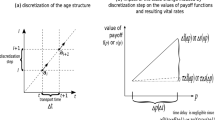Abstract
Intra-specific competition defines the relationship between population density and the performance of individual organisms (R-function). Observation of this relationship in nature shows it to be frequently nonlinear, and it has been argued, on intuitive grounds, that this nonlinearity is due to the type of competition (scramble or contest) being expressed. Here, we use an individual-based simulation model to investigate the effects of three resource partitioning schemes, representing different types of competition, on the form of the R-function. Results indicate that all resource partitioning schemes can give rise to concave or convex functions depending on the balance between maximum individual birth rate, maintenance cost, and demand for resources. Given high growth rates and maintenance costs, contest competitors tend to exhibit less concavity than scramblers. Therefore, population stability can be strongly affected by the strategy of resource partitioning. Life histories and environmental conditions that encourage the homogeneous distribution of resources among individuals lead to complex and unstable dynamics. Stable dynamics is fostered by heterogeneous resource distribution, which could result from such things as social hierarchies, individual and environmental variability, and large, indivisible resource packets.








Similar content being viewed by others
References
Łomnicki A, Sedziwy S (1988) Resource partitioning and population stability under exploitation competition. J Theor Biol 132:119–120
Łomnicki A, Sedziwy S (1989) Do individual-differences in resource intakes without monopolization cause population stability and persistence? J Theor Biol 136:317–326
Bates DM, Watts DG (1988) Nonlinear regression analysis and its applications. Wiley, London
Bellows TS (1981) The descriptive properties of some models for density dependence. J Anim Ecol 50:139–156
Berryman AA (1999) Principles of population dynamics and their application. Stanley Thornes, Cheltenham, UK
Berryman A, Lima M (2006) Deciphering the effects of climate on animal populations: diagnostic analysis provides new interpretation of Soay sheep dynamics. Am Nat 168:784–795
Berryman AA, Michalski J, Gutierrez AP, Artiditi R (1995) Logistic theory of food web dynamics. Ecology 76:336–343
Beverton RJH, Holt SJ (1957) On the dynamics of exploited fish populations. HM Stationary Office, London
Bjørnstad ON, Hansen TF (1994) Individual variation and population dynamics. Oikos 69:167–171
Brännström Å, Sumpter DJT (2005) The role of competition and clustering in population dynamics. Proc R Soc Lond B 272:2065–2072
Burkey TV, Stenseth NC (1994) Population dynamics of territorial species in seasonal and patchy environments. Oikos 69:47–53
Burnett T (1958) Dispersal of an insect parasite over a small plot. Can Entomol 90:279–283
Dennis B, Desharnais RA, Cushing JM, Henson SM, Costantino RF (2001) Estimating chaos and complex dynamics in an insect population. Ecol Monogr 71:277–303
Eskola TM, Geritz SAH (2007) On the mechanistic derivation of discrete-time population models by varying within-season patterns of reproduction and aggression. B Math Biol 69:329–346
Fujita H, Utida F (1952) The effect of population density on the growth of an animal population. Res Popul Ecol 1:1–14 (in Japanese, translated into English in: Ecology 34:488–498)
Geritz SAH, Kisdi E (2004) On the mechanistic underpinning of discrete-time population models with complex dynamics. J Theor Biol 228:261–269
Getz WM (1996) A hypothesis regarding the abruptness of density dependence and the growth rate of populations. Ecology 77:2014–2026
Gilpin ME, Ayala FJ (1973) Global models of growth and competition. Proc Natl Acad Sci USA 70:3590–3593
Ginzburg LR, Colyvan M (2003) Ecological orbits: how planets move and populations grow. Oxford University Press, Oxford
Hassell MP (1975) Density-dependence in single-species populations. J Anim Ecol 44:283–295
Hassell MP, Lawton JH, May RM (1976) Patterns of dynamical behaviour in single species populations. J Anim Ecol 45:471–486
Johansson A, Sumpter DJT (2003) From local interactions to population dynamics in site-based models of ecology. Theor Popul Biol 64:497–517
Johst K, Brandl R (1997) The effect of dispersal on local population dynamics. Ecol Model 104:87–101
Johst K, Doebeli M, Brandl R (1999) Evolution of complex dynamics in spatially structured populations. Proc R Soc Lond B 266:1147–1154
May RM (1974) Biological populations with non-overlapping generations: stable points, stable cycles, and chaos. Science 186:645–647
Maynard-Smith J, Slatkin M (1973) The stability of predator–prey systems. Ecology 54:384–391
Nelder JA (1961) The fitting of a generalization of the logistic curve. Biometrics 17:89–110
Nicholson AJ (1954) An outline of the dynamics of animal populations. Aust J Zool 2:9–65
Richards FJ (1959) A flexible growth function for empirical use. J Exp Bot 10:290–300
Ricker WE (1954) Stock and recruitment. J Fish Res Bd Can 11:559–623
Royama T (1977) Population persistence and density dependence. Ecol Monogr 47:1–35
Royama T (1992) Analytical population dynamics. Chapman & Hall, London
Schoener TW (1973) Population growth regulated by intraspecific competition for energy or time: Some simple representations. Theor Popul Biol 4:56–84
Travis JMJ (2003) Neighbourhood size, dispersal distance and the complex dynamics of the spatial Ricker model. Popul Ecol 45:227–237
Turchin P (2003) Evolution in population dynamics. Nature 424:257–258
Turchin P, Taylor AD (1992) Complex dynamics in ecological time series. Ecology 73:289–305
Uchmanski 0J (2000) Resource partitioning among competing individuals and population persistence: an individual-based model. Ecol Model 131:21–32
Acknowledgments
We thank Adam Łomnicki and Tim Coulson for their helpful comments on an earlier version of this manuscript.
Author information
Authors and Affiliations
Corresponding author
Rights and permissions
About this article
Cite this article
Johst, K., Berryman, A. & Lima, M. From individual interactions to population dynamics: individual resource partitioning simulation exposes the causes of nonlinear intra-specific competition. Popul Ecol 50, 79–90 (2008). https://doi.org/10.1007/s10144-007-0061-5
Received:
Accepted:
Published:
Issue Date:
DOI: https://doi.org/10.1007/s10144-007-0061-5




